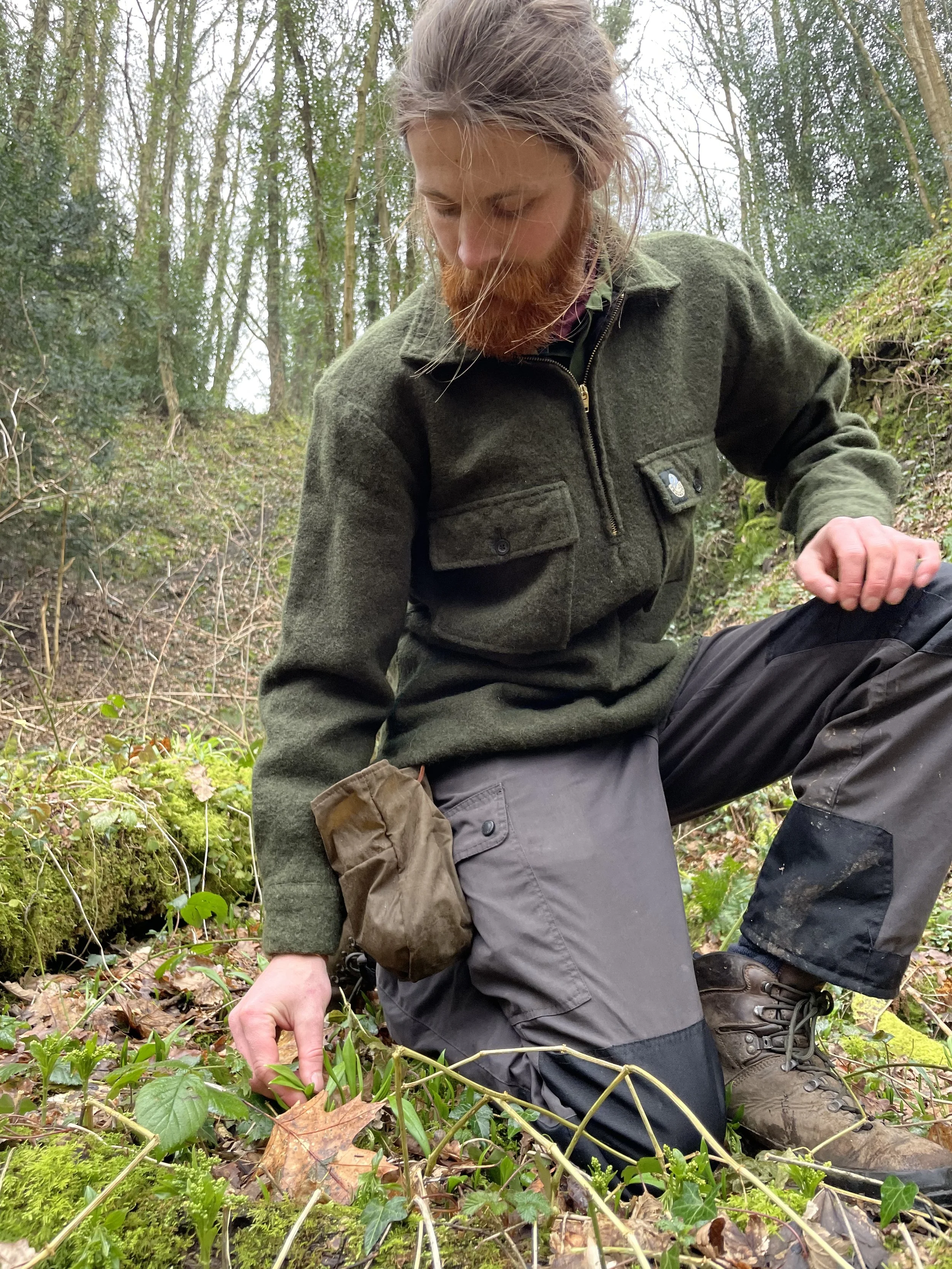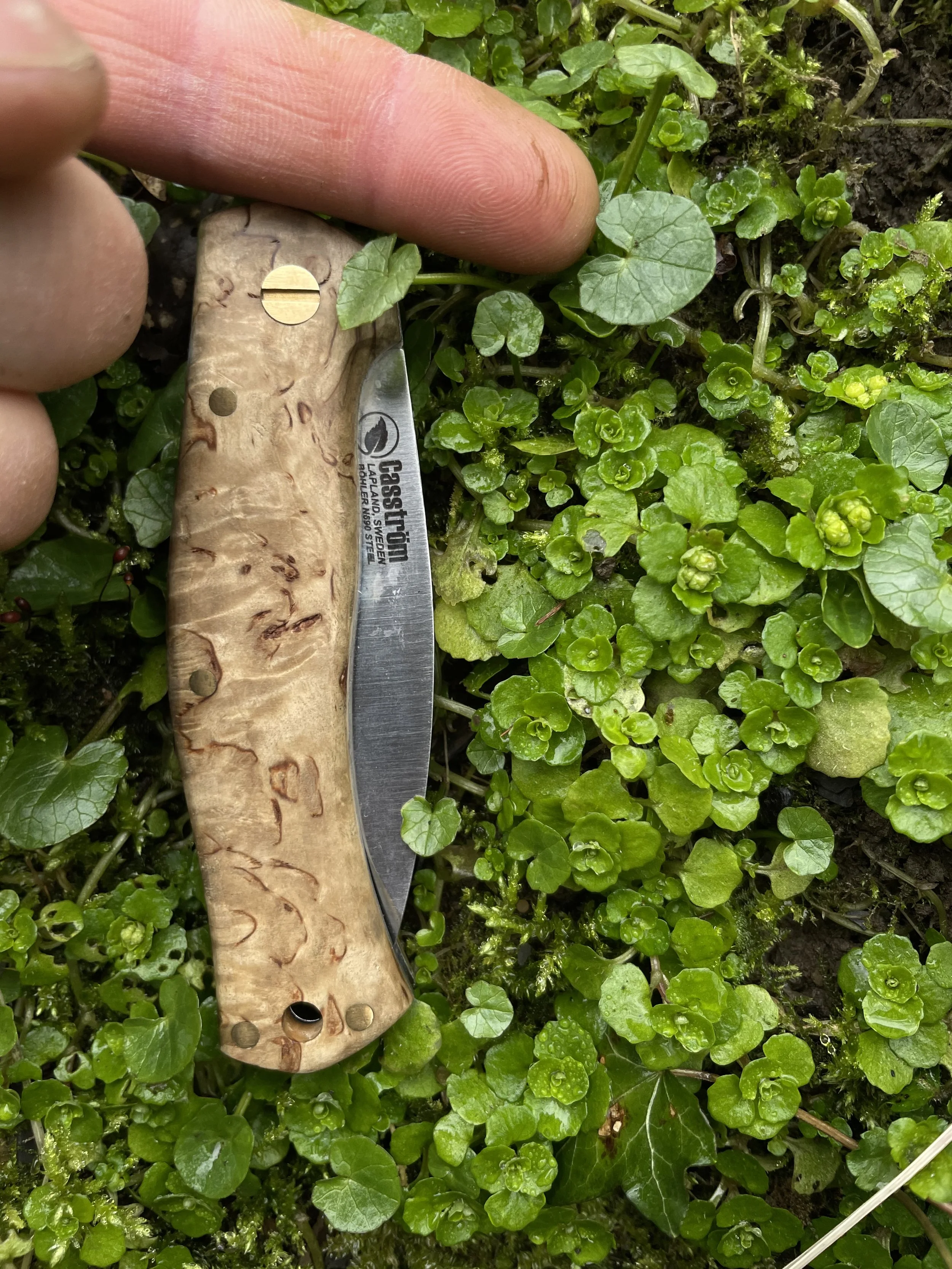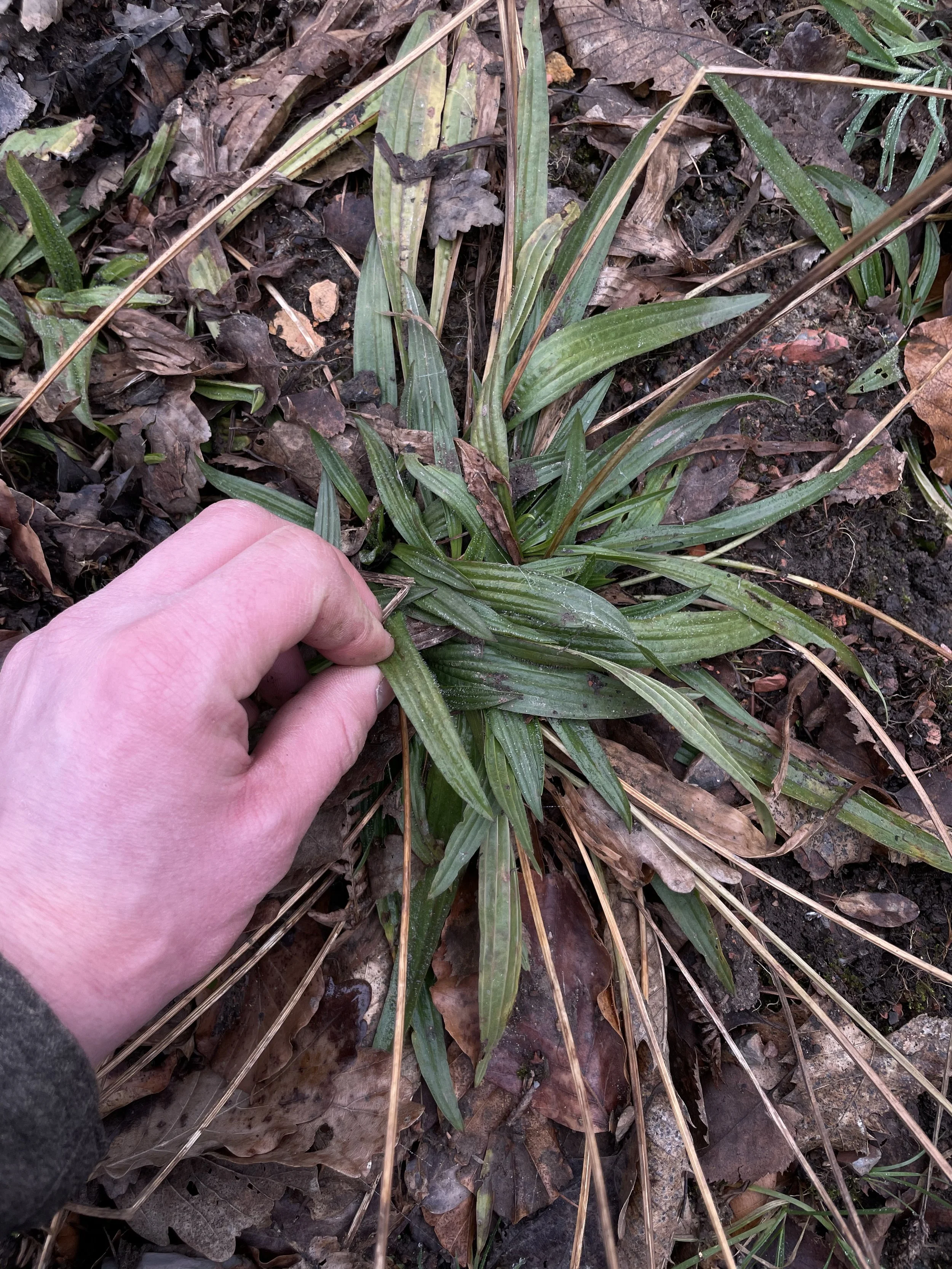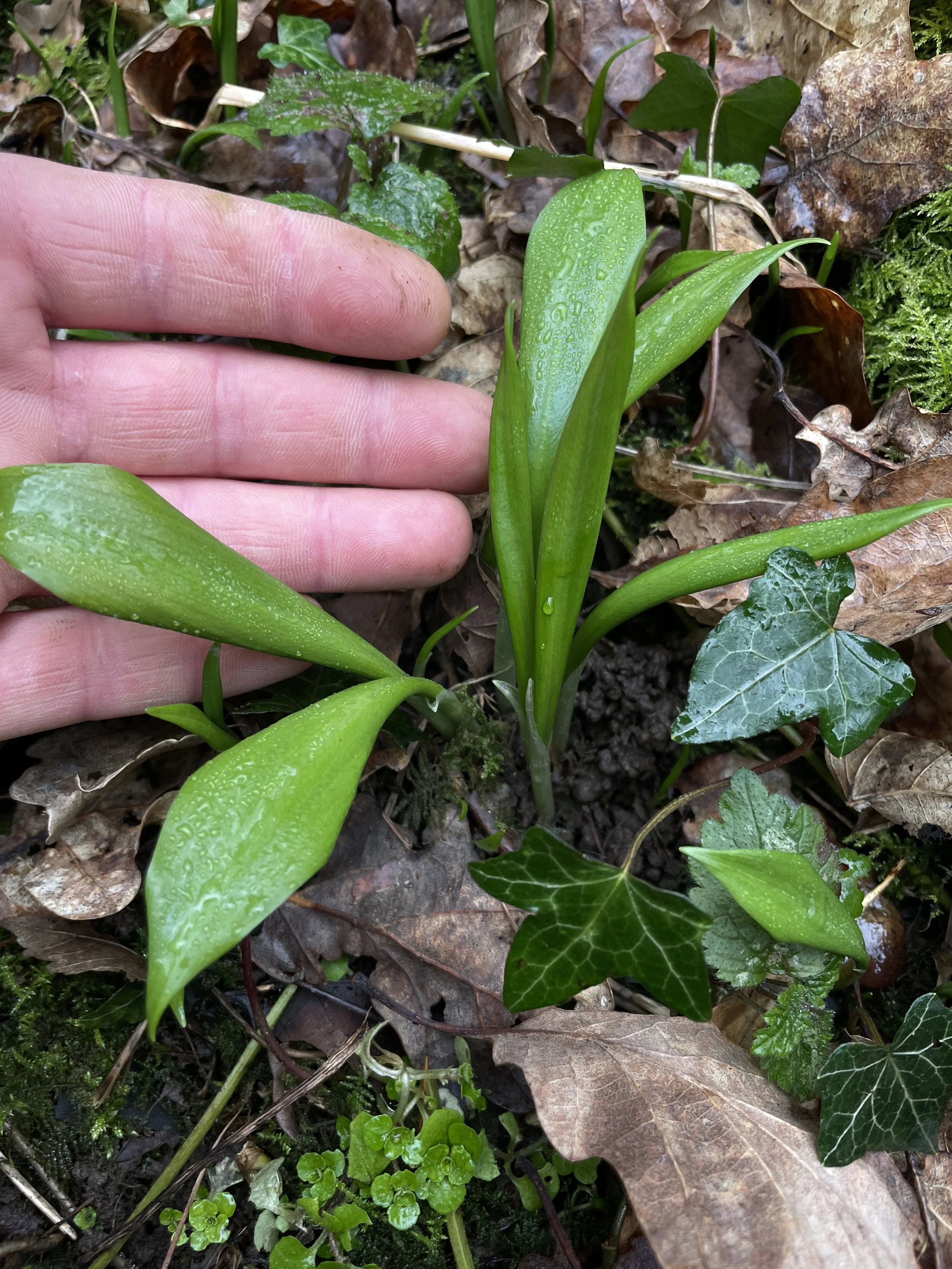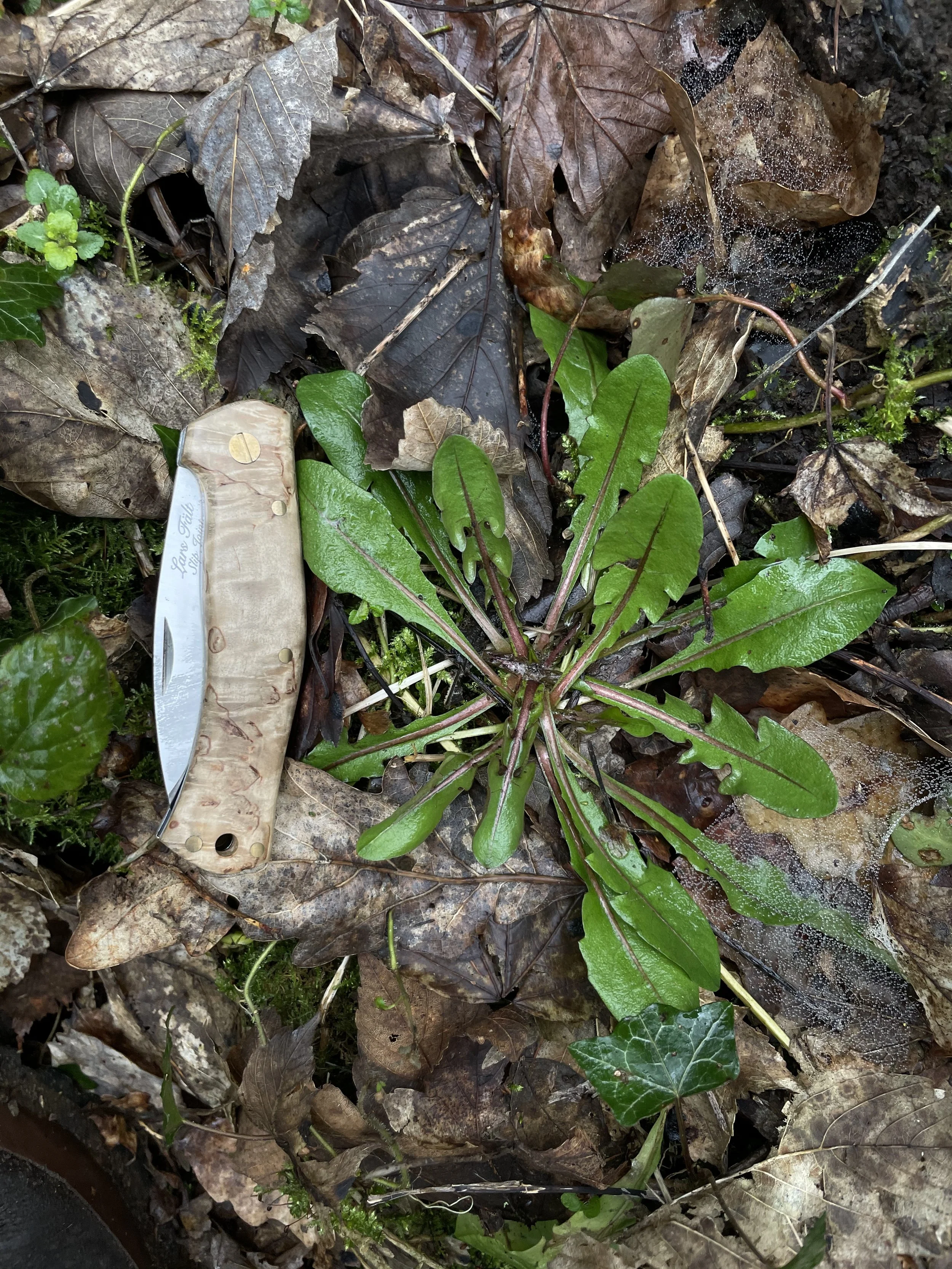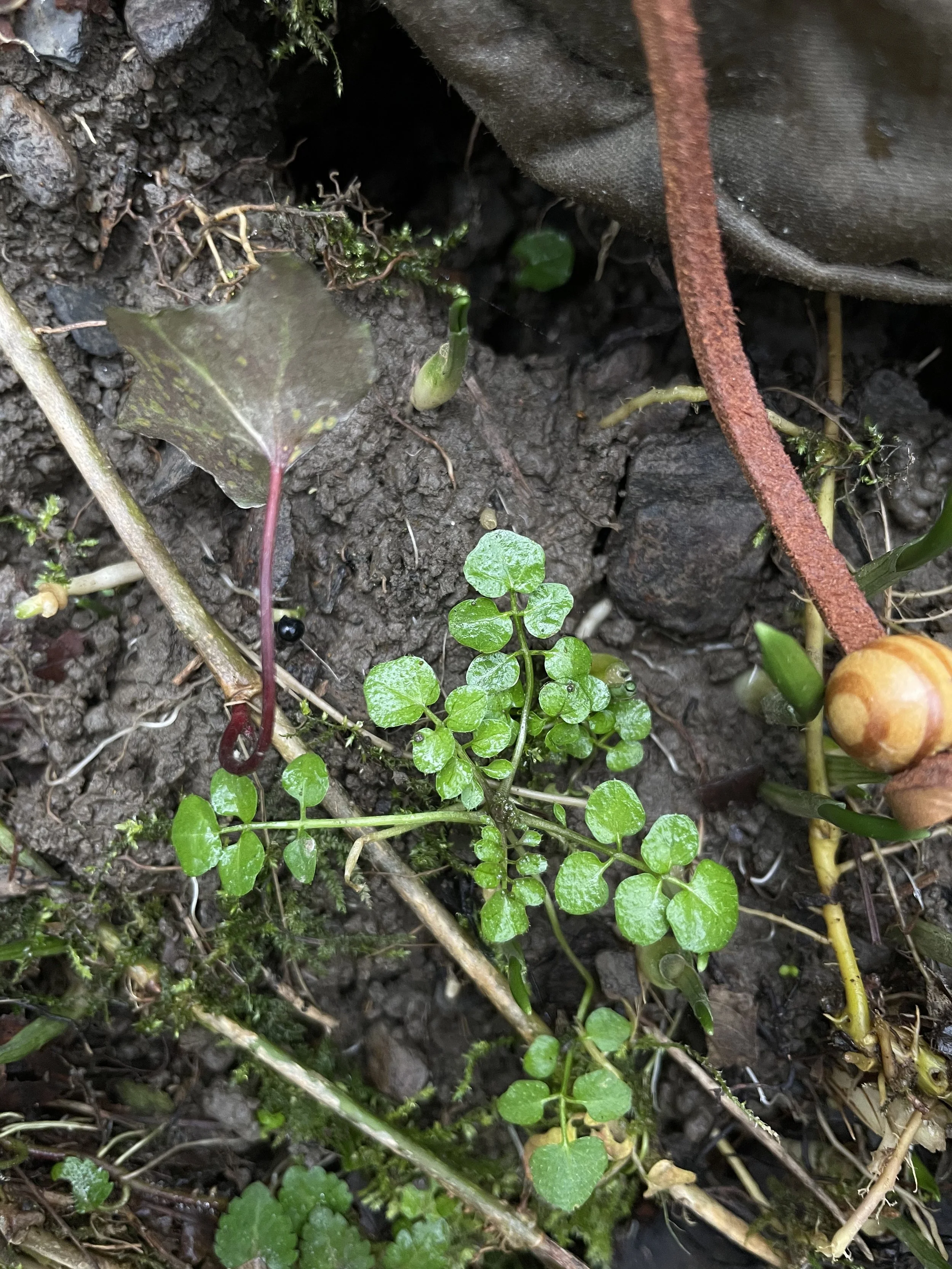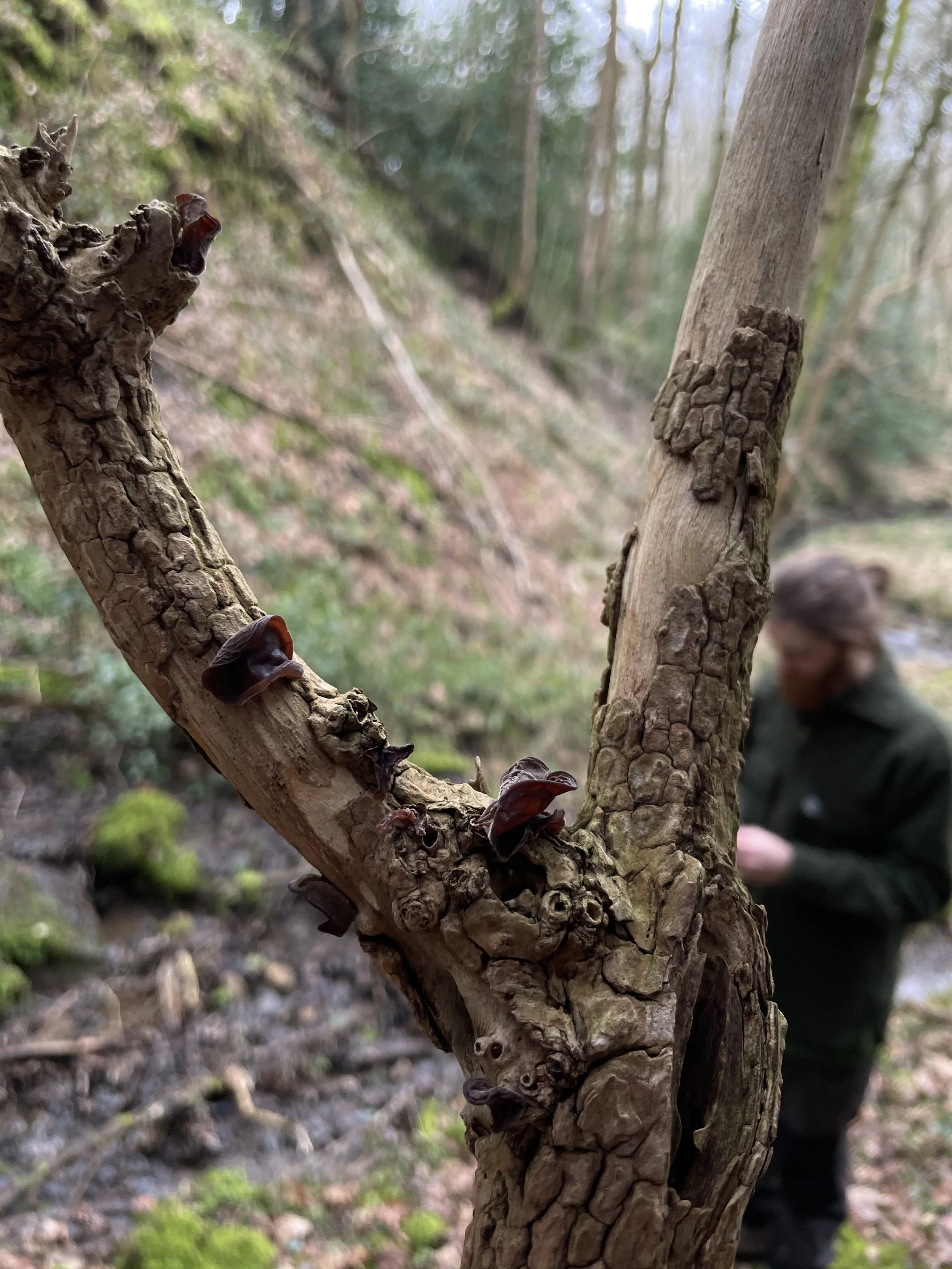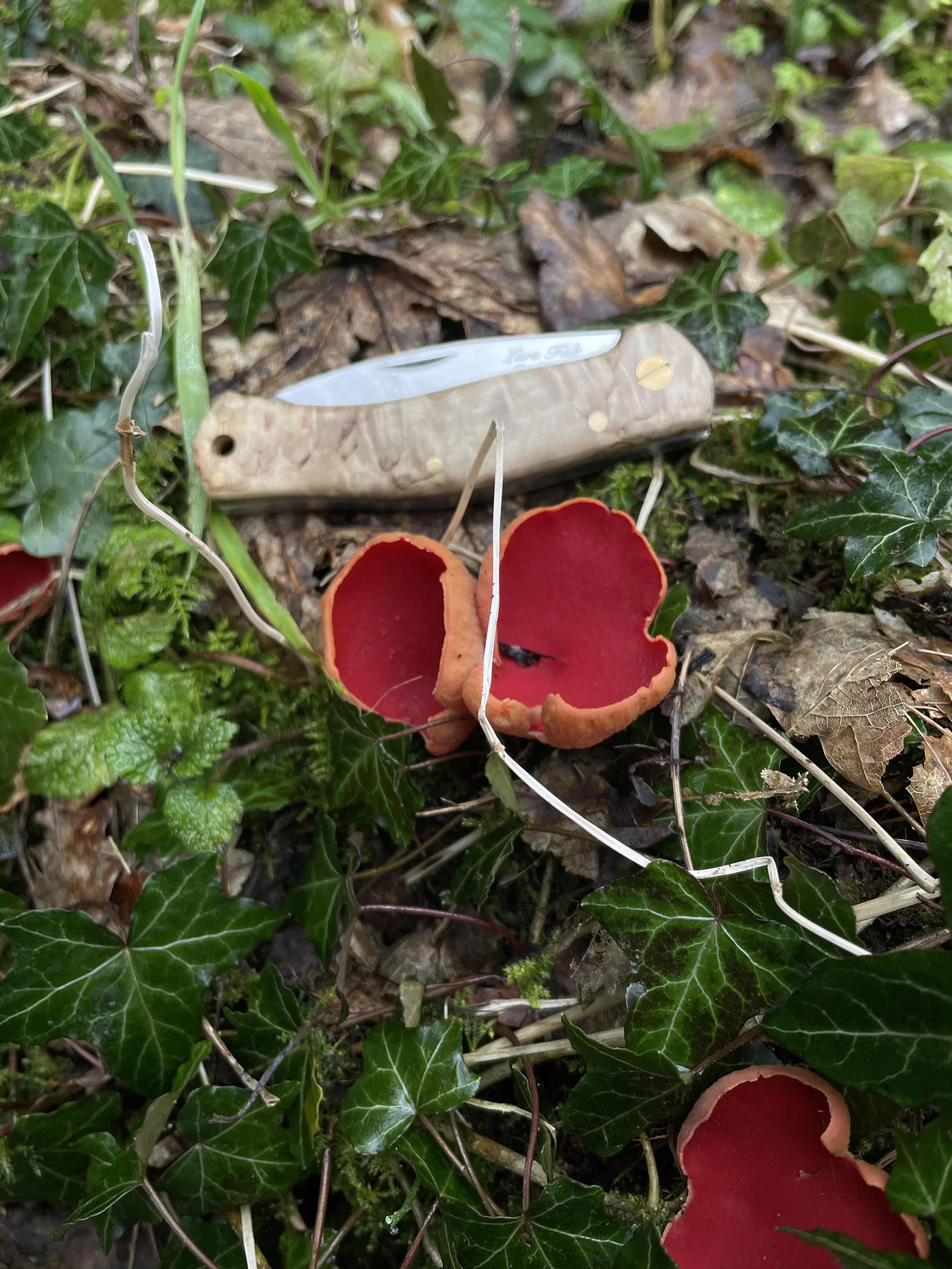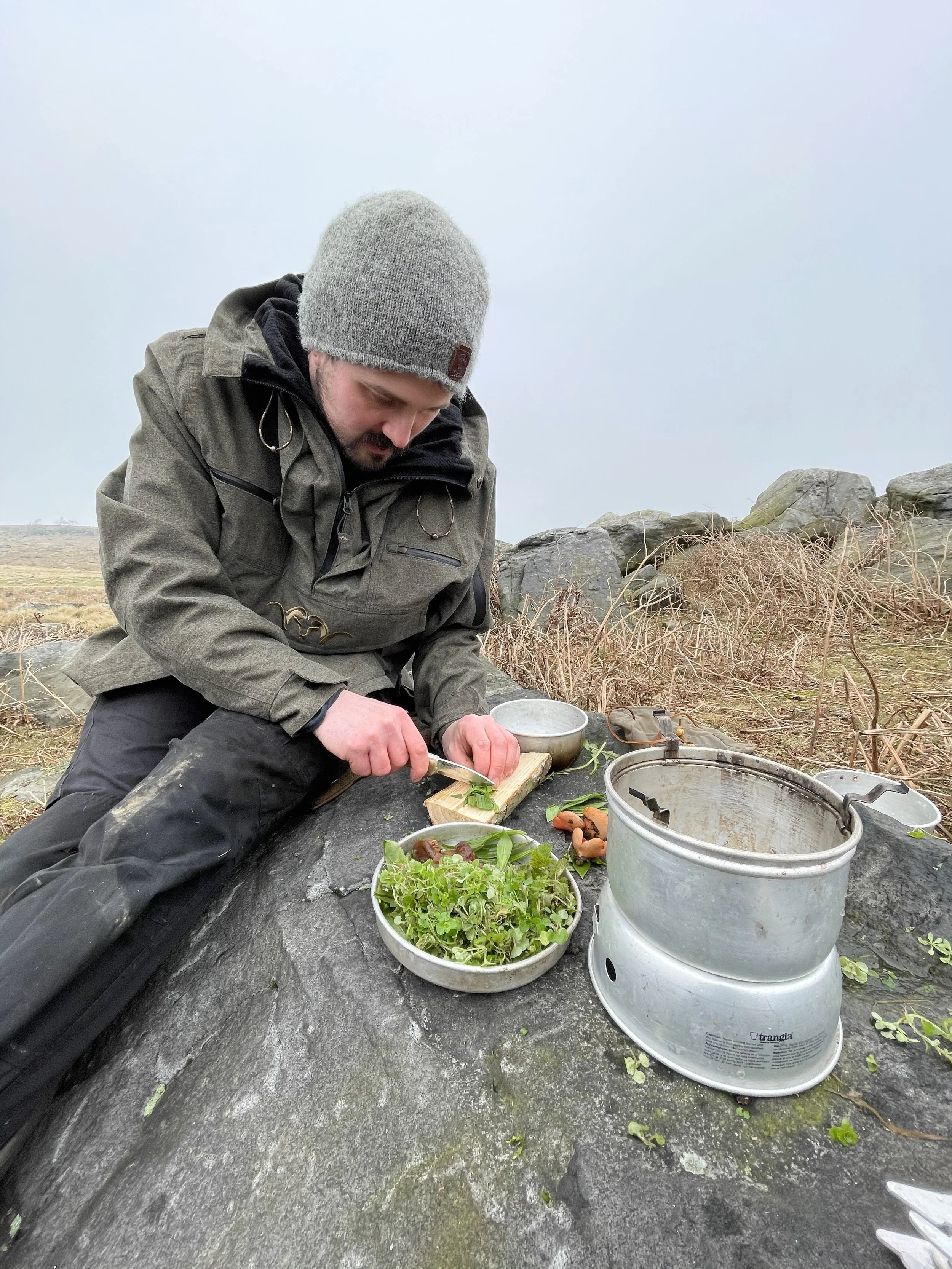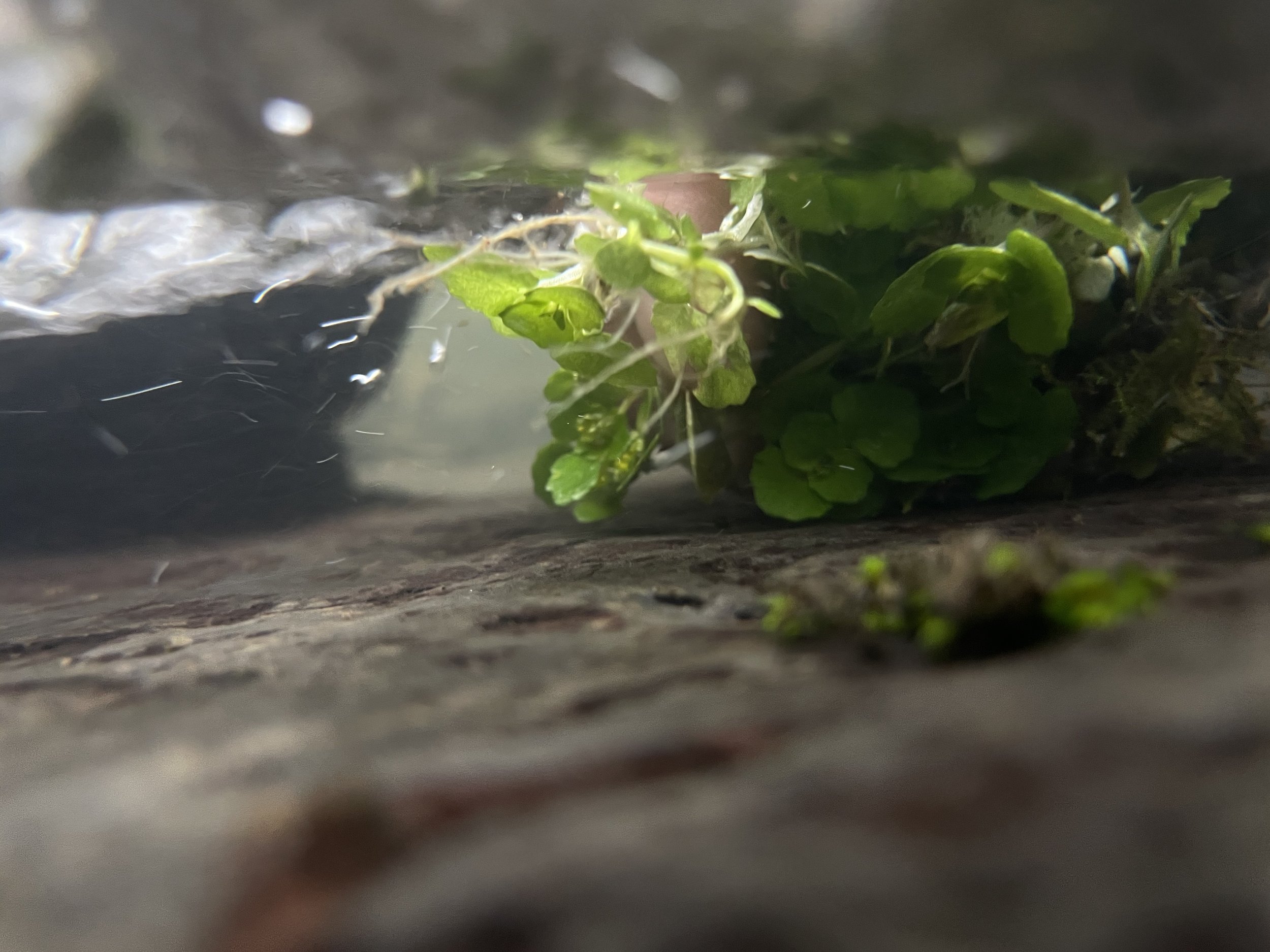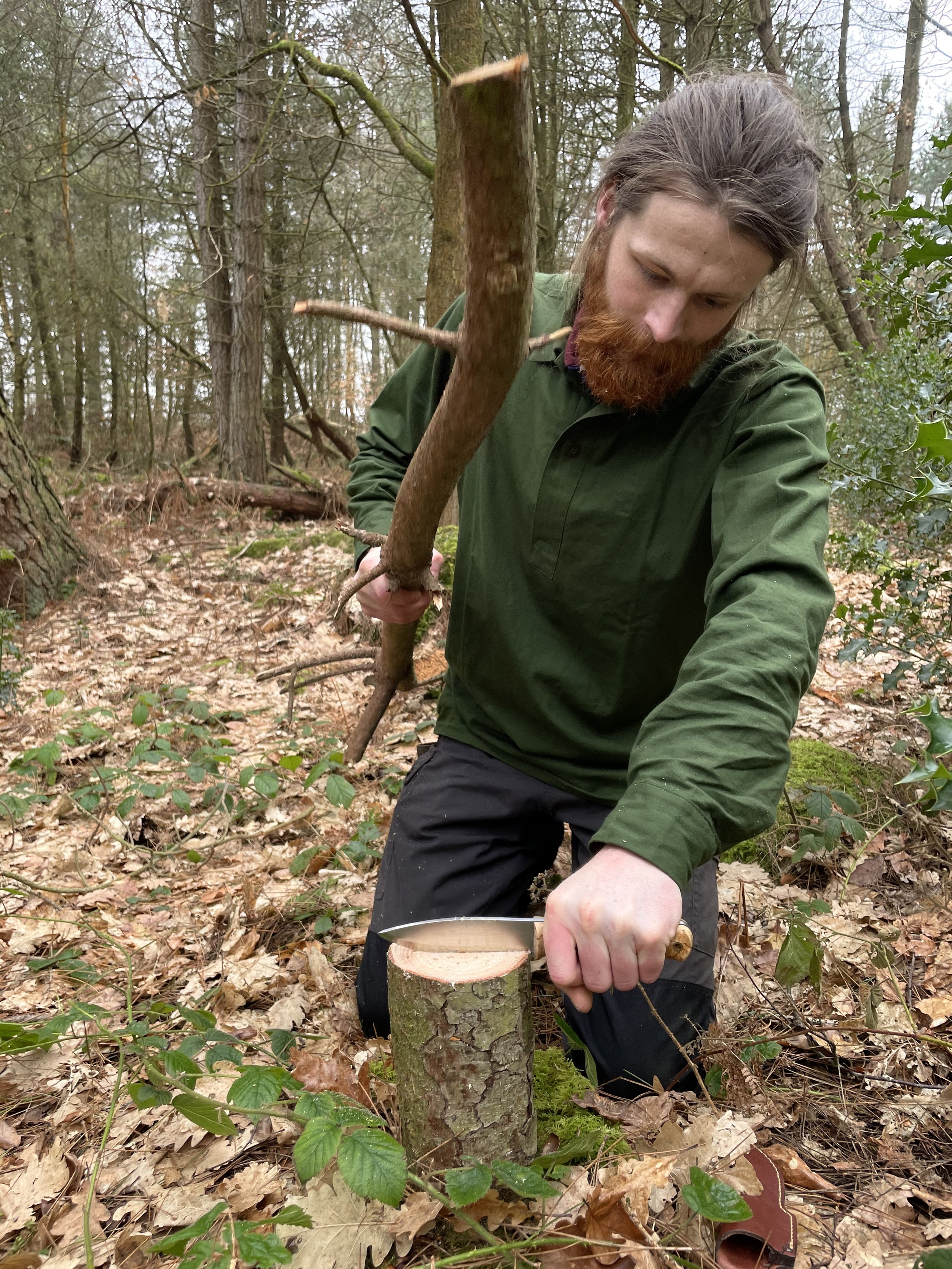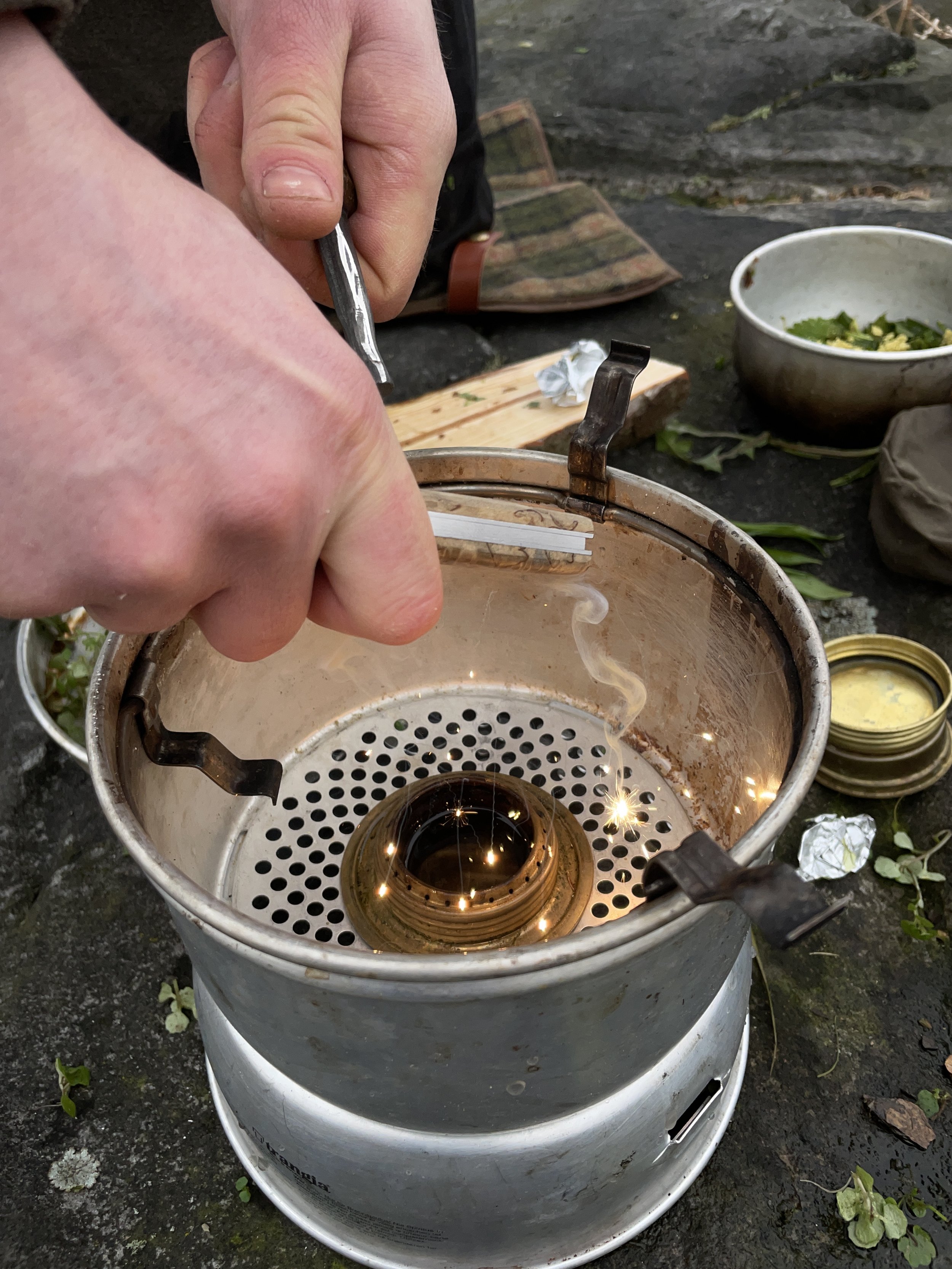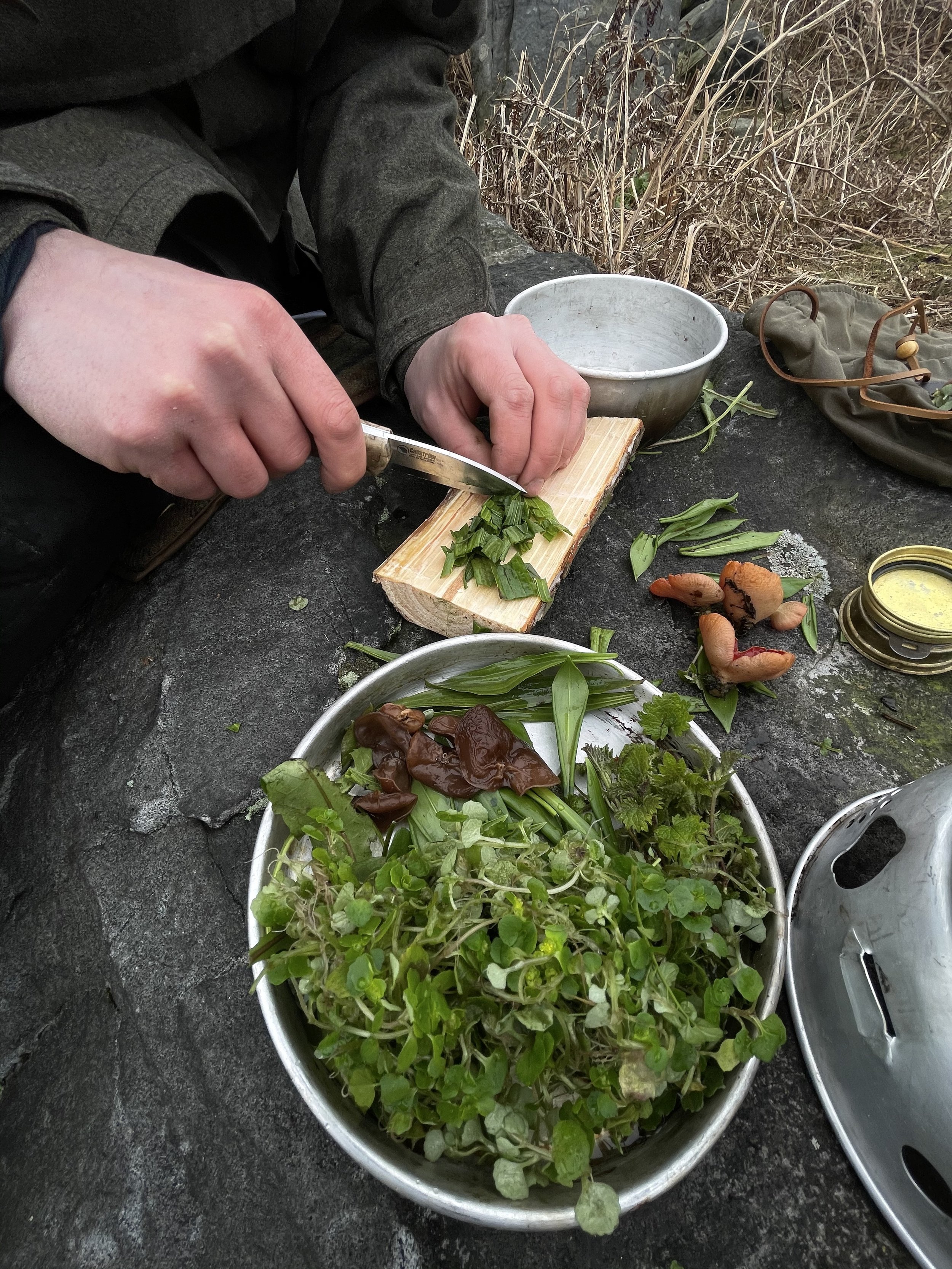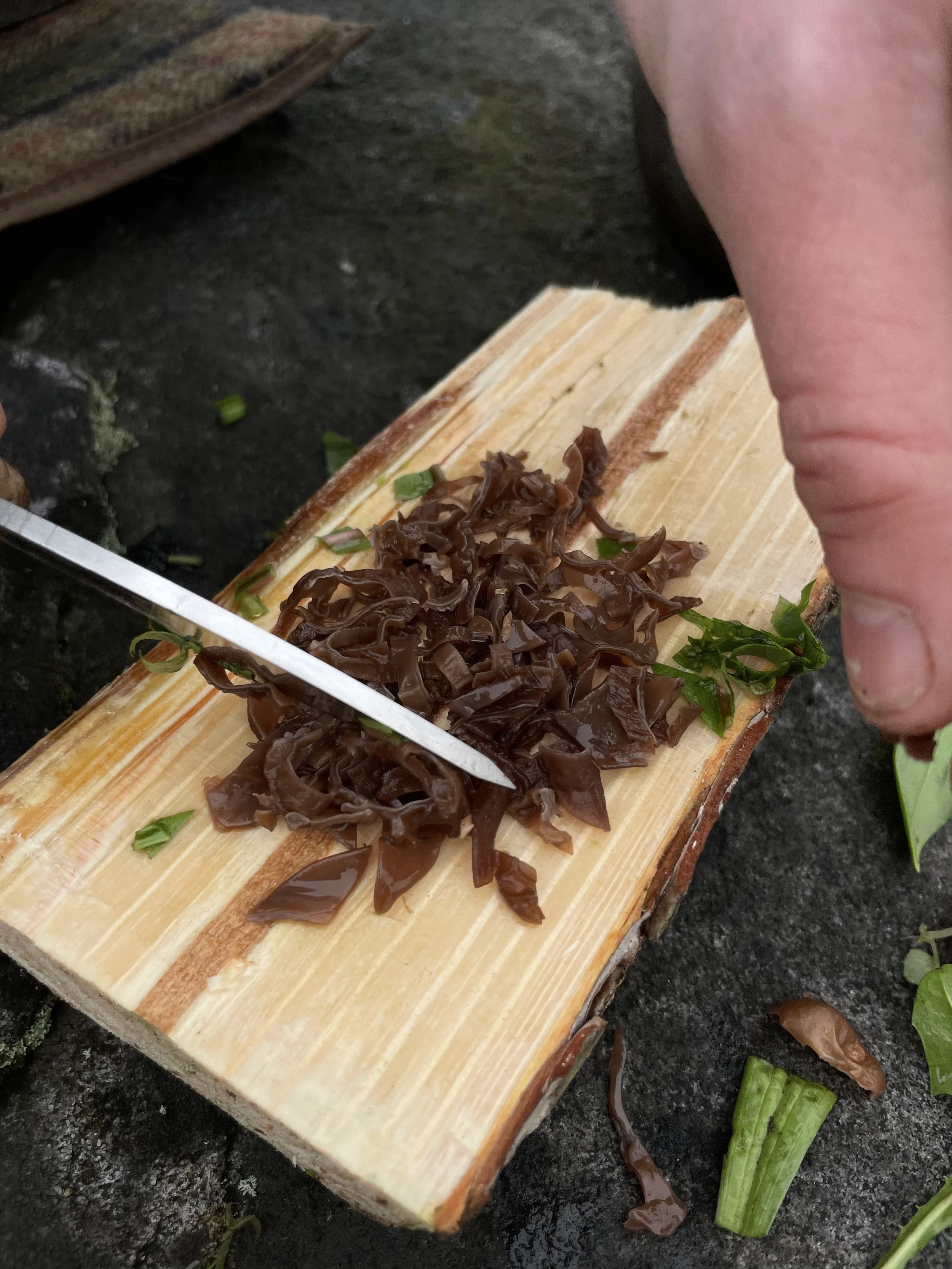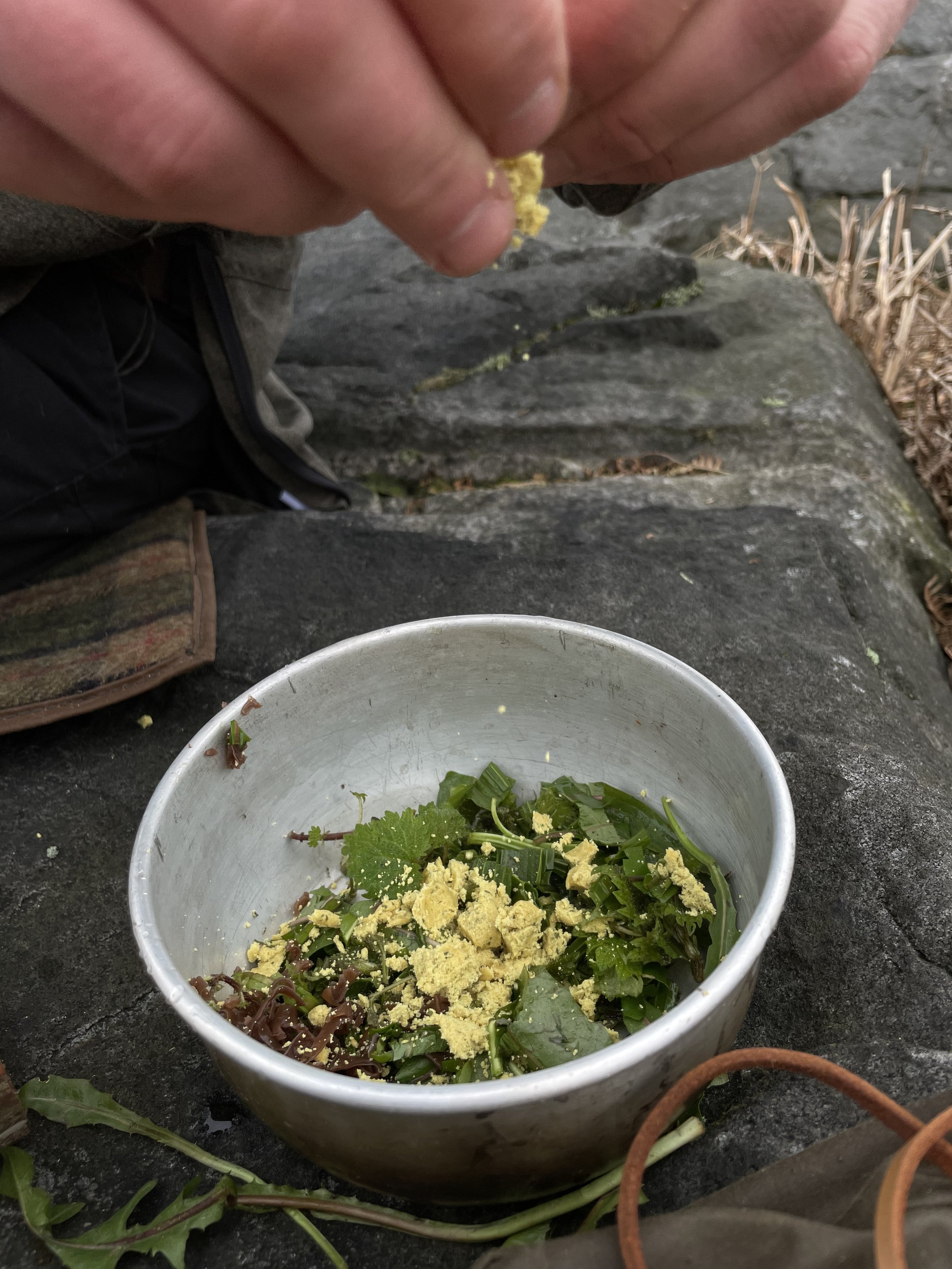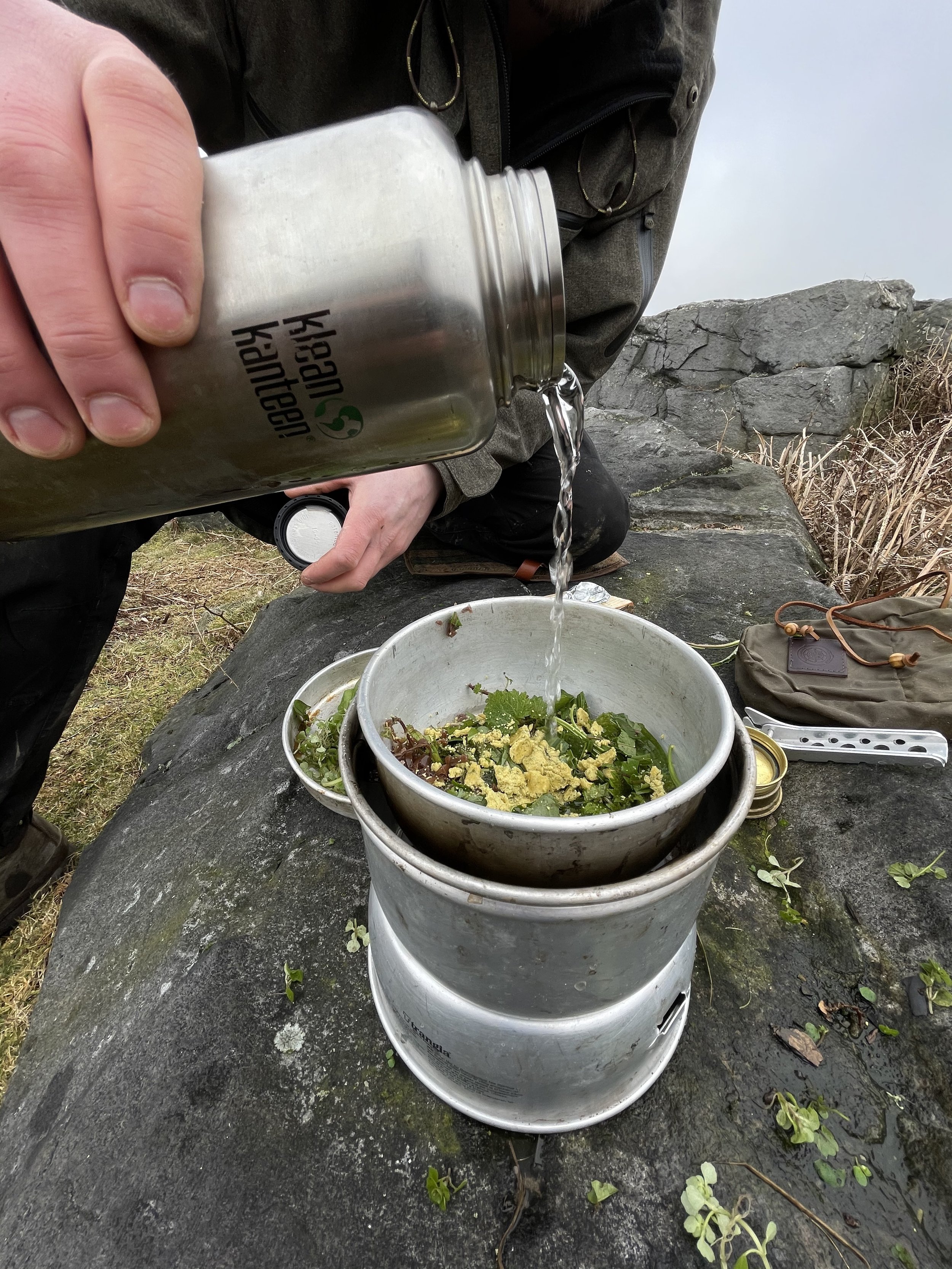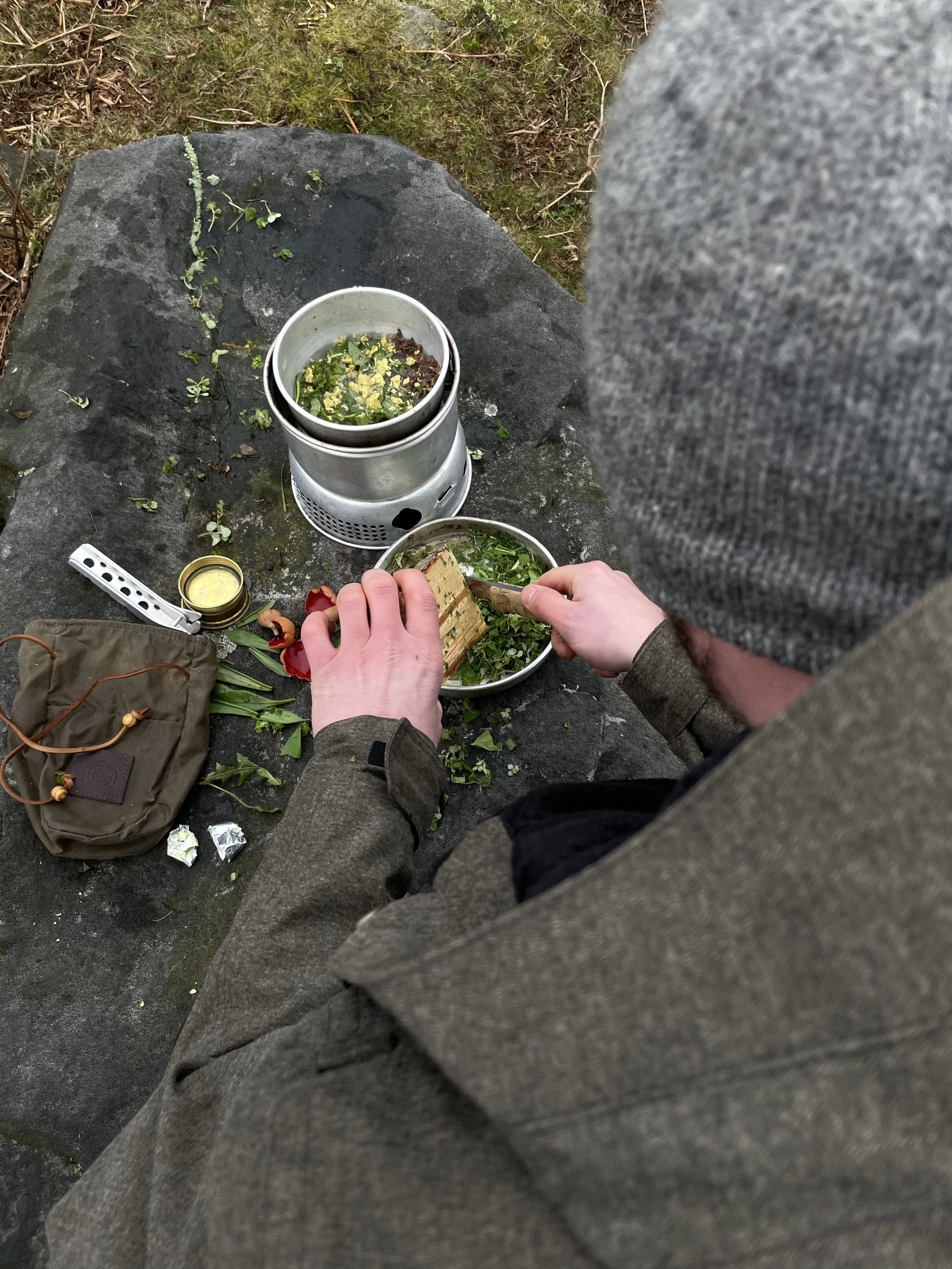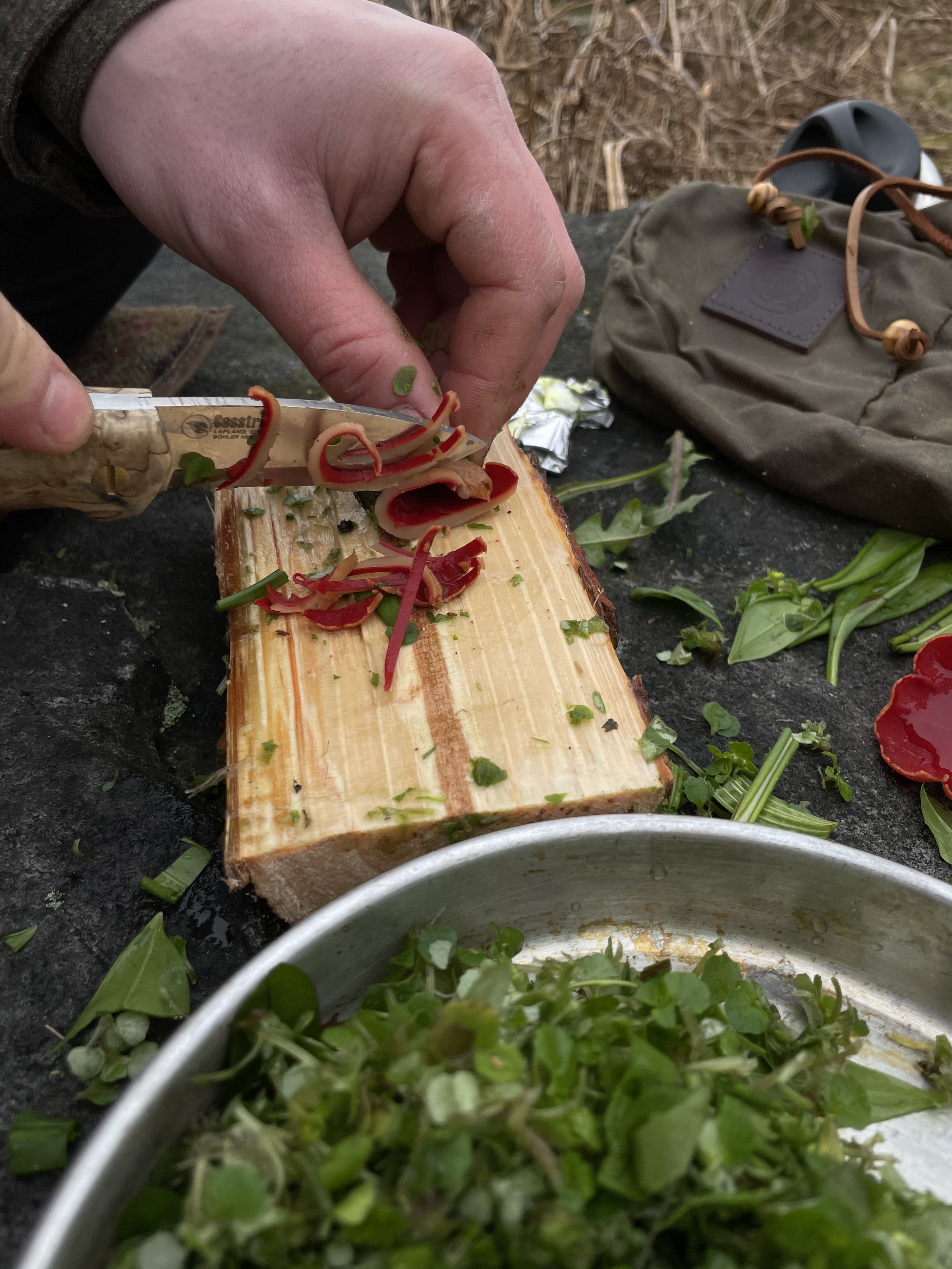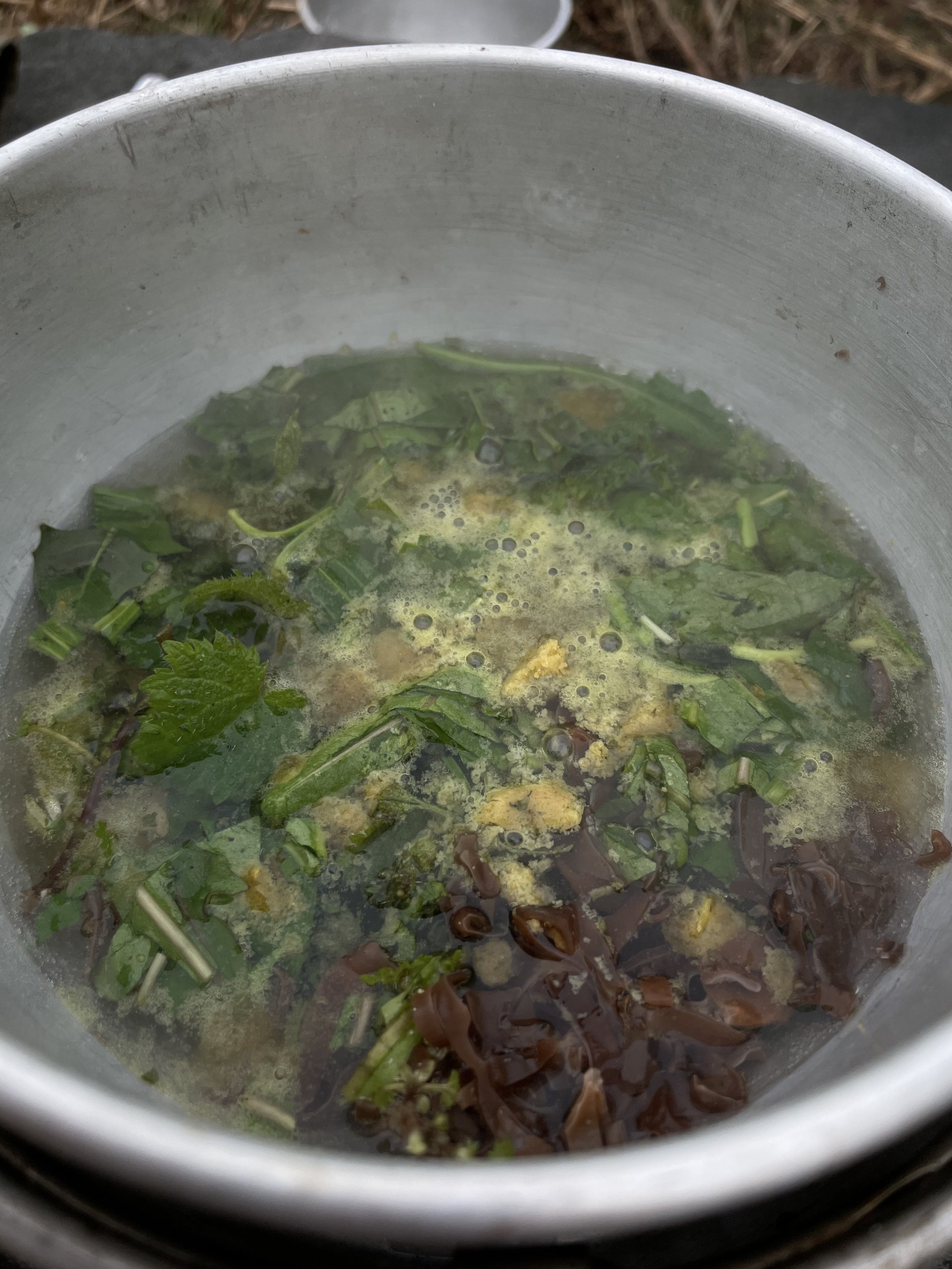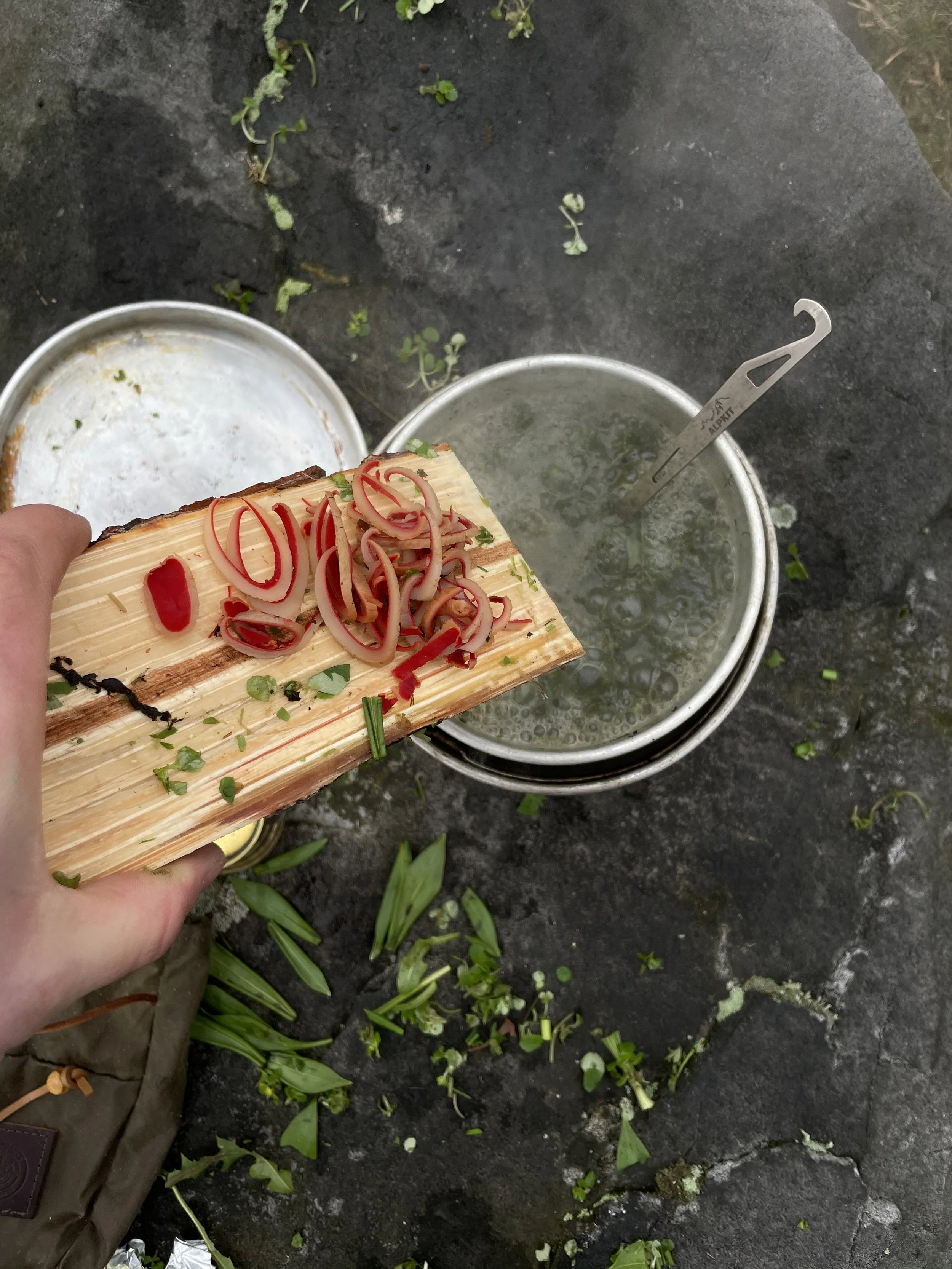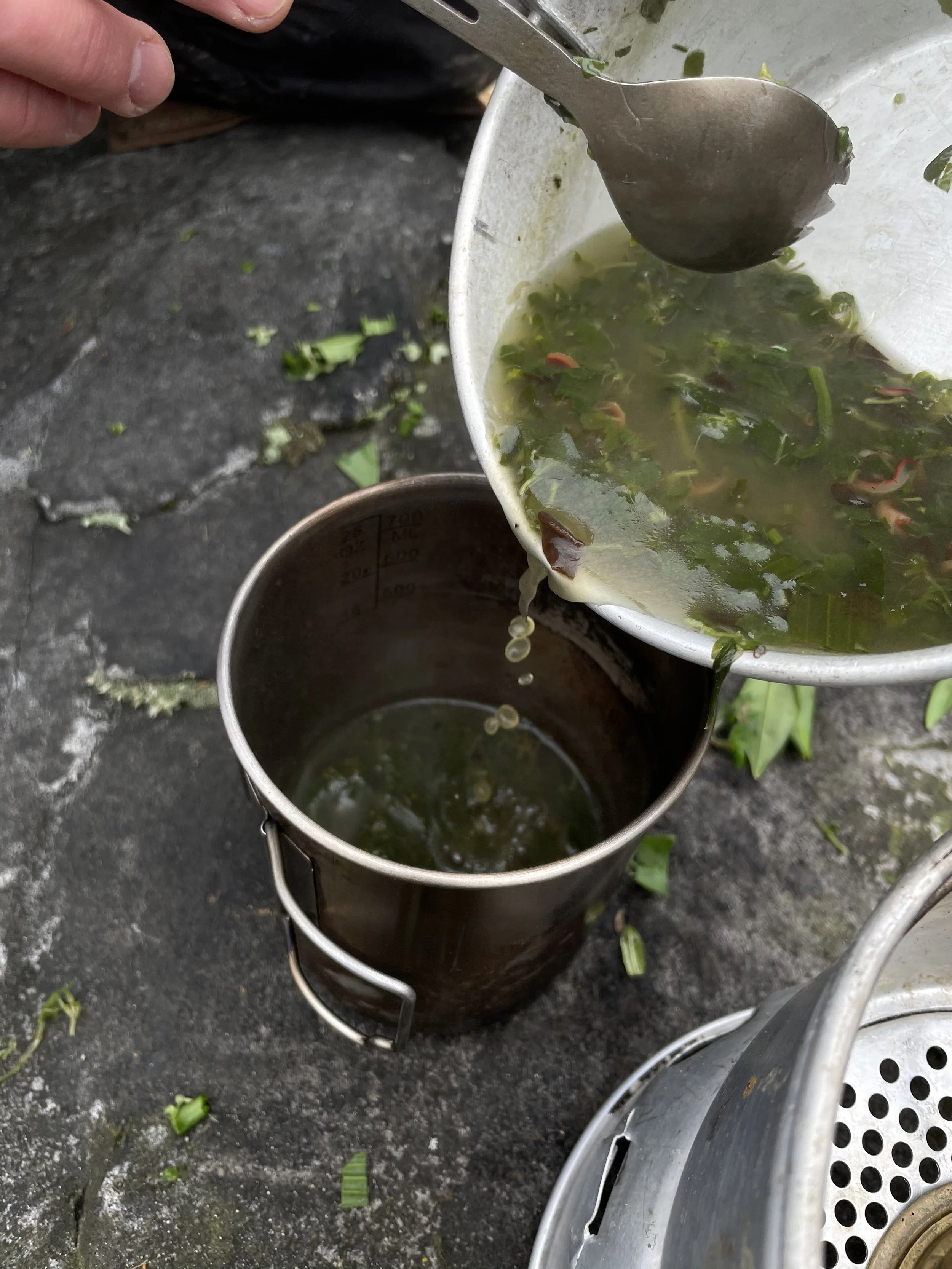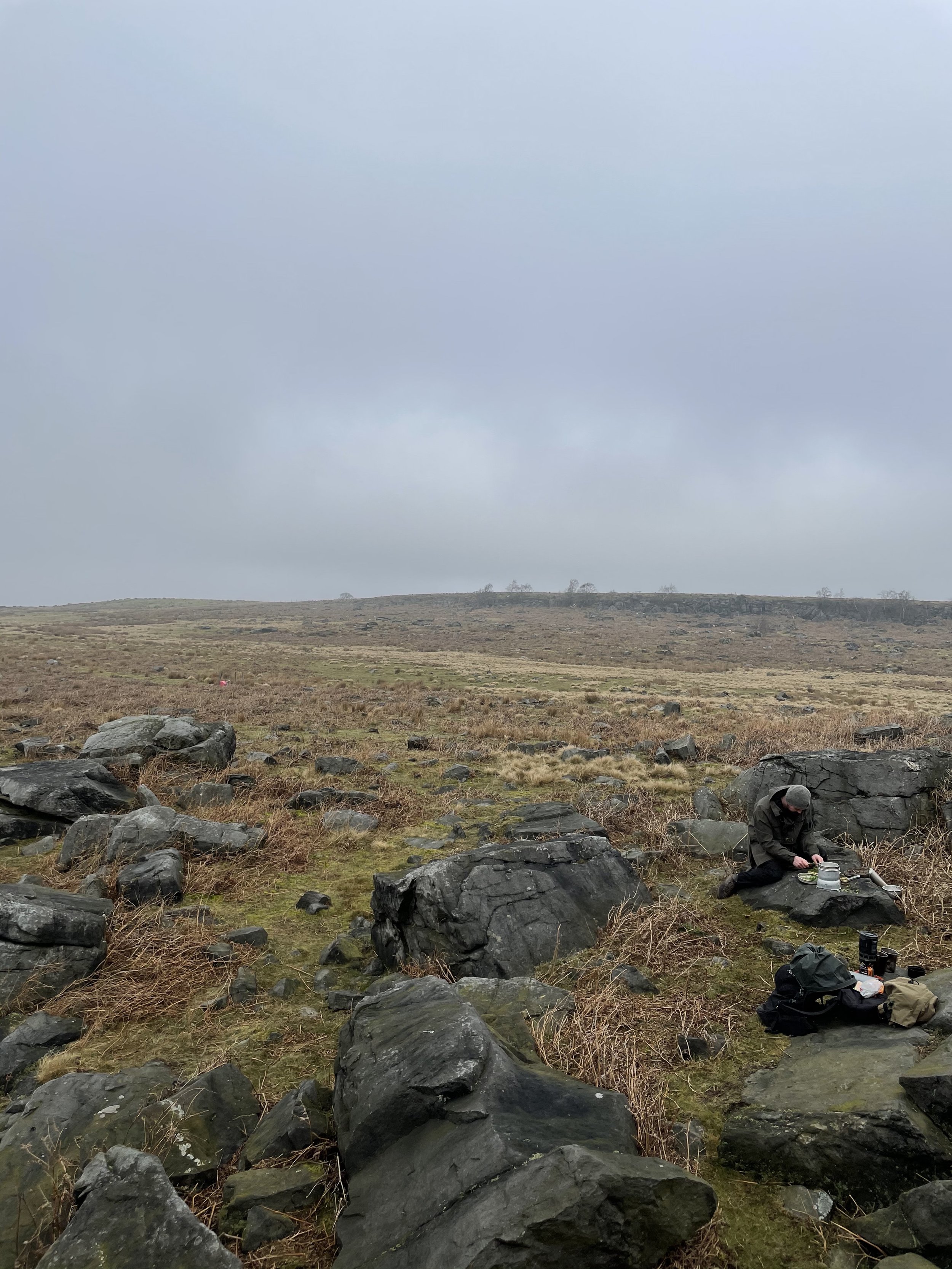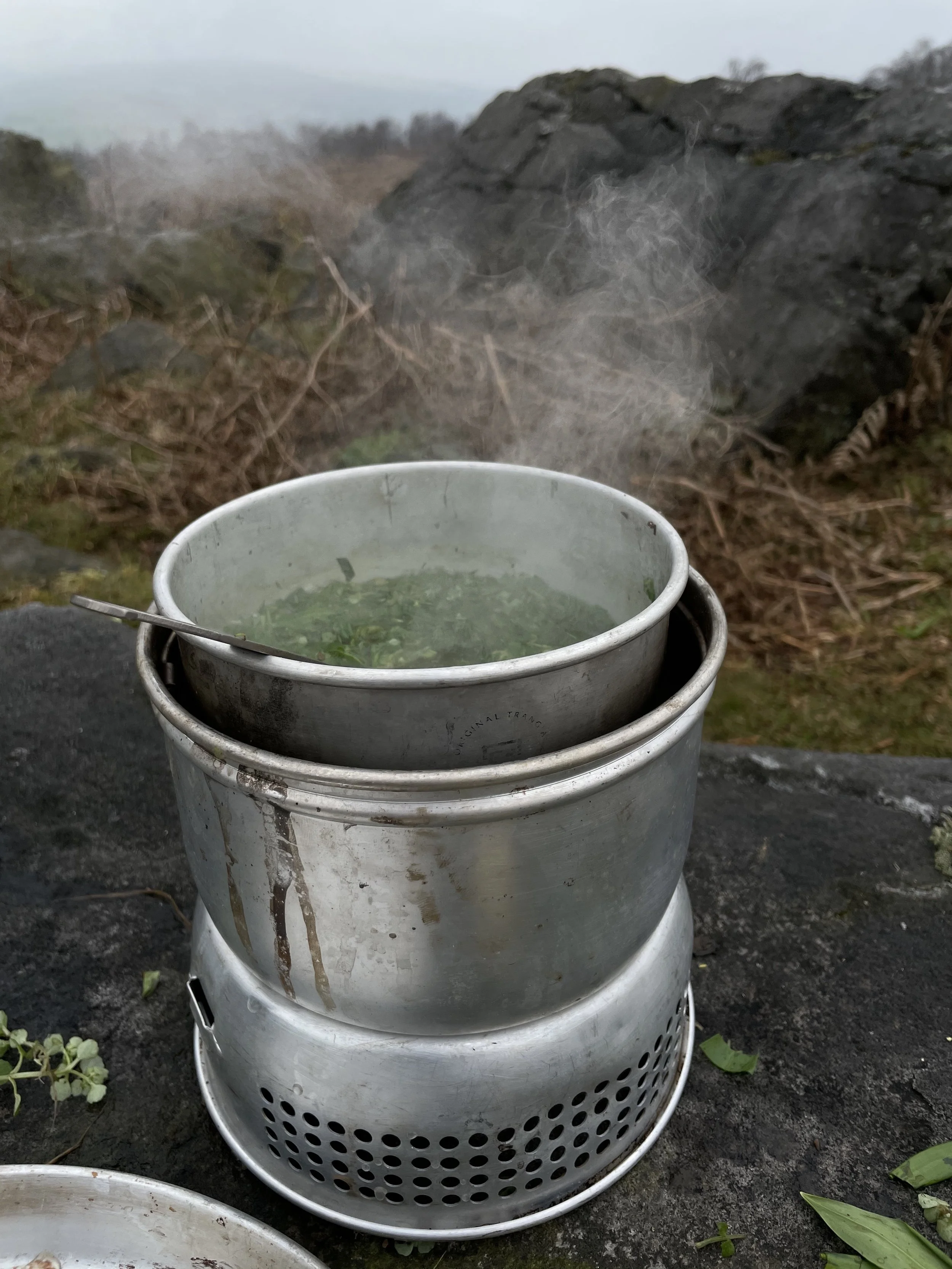Foraged Early Spring Greens Soup
Jamie Dakota
One of my favourite ways to get connected with nature in the early spring, before even the sap is rising in the Birches, is to test my plant ID with the young new growth of woodland plants and make a soup from those plants I can identify 100%. In this way my ingredient list gets longer each year, and I’m noting which plants to come back to as the season progresses to see whether any plant which didn’t make the 100% mark can be correctly identified.
Another general method I apply is to collect plants as I find them, when on a hike or other journey. In this way I’m not actively ‘hunting’ for plants but rather allowing my senses to tune into what’s around it, letting my journey build the ingredients list.
An additional benefit of all this is of course that you supplement what you carry in your rucksack to bulk out a light meal with extra vitamins and calories at a time of year when traditionally we’d be in need of those resources after a long winter. I typically always have a packet soup or a couple of stock cubes in my pack for a lunch stop, and what a wonderful feeling to add into that simple ration the earliest of nature's free food.
As with all articles foraging related, please do your own research and be sure to know without doubt which plants you are collecting.
This article then, whilst a full recipe in itself, is mostly meant to inspire. Learn a few easily identified plants, and get experimenting with ways to include them in your diet. I took a walk with my friend and colleague Max during some course preparations in late February, and this is the soup we made after 15 minutes of effort in collecting.
Ingredients:
Opposite leaved Golden Saxifrage - Chrysosplenium oppositifolium
Ribwort Plantain - Plantago Lanceolata
Ramsons - Allium Ursinum
Dandelion - Taraxacum Officinale
Nettles - Urtica Dioica
Hairy Bittercress - Cardamine hirsuta
Judas’ Ear Fungus - Auricularia auricula-judae
Scarlet Elf Cups - Sarcoscypha coccinea
1 Vegetable Stock Cube
500ml Water
We made enough with the pictured quantity for two of us to have around a 300ml mug of soup each.
Opposite Leaved Golden Saxifrage - Chrysosplenium oppositifolium
Knife for scale. NOTE: what I’m pointing at is poisonous
Saxifrage is at it’s very best in the early Spring. Once this plant matures a little it can get quite bitter and loses its value for me as a salad plant. But even later in the year it’s still worthwhile as a potherb providing you can dilute or mask the bitterness. No need to worry about that for us today though, so we collect a good volume of this plant as it grows thickly and will provide a very mild bulk to our soup. It’s worth noting that all plants collected from waterways could harbour pathogens such as liver fluke, so ensuring they’re cooked to an adequate temperature is important. NOTE: in the photo you can see I’m pointing to the leaf of a Lesser Celandine Plant, a poisonous plant growing amongst the edible Saxifrage… beware you don’t grab the wrong plant in with your target plant.
Ribwort Plantain - Plantago Lanceolata
Ribwort Plantain is a very common path-side plant, where it’s often beaten up a bit underfoot or soiled by dogs, so I tend to be quite picky about where I collect it from and also in selecting the very best looking leaves. With good young leaves though both Ribwort and Greater Plantain (Plantago Major) are a good source of vitamin A and calcium, as well as containing mucilage. A good medicinal use for both these plants is to create a spit poultice to treat insect bites; or steeped in a tea and drunk to help runny noses and eyes, and sore throats as they’re soothing, antispasmodic and anti-inflammatory. In our soup though they’ll act as something of a robust green leaf akin to cabbage or spinach.
Ramsons - Allium Ursinum
Ramsons, or wild garlic, are probably the most well known wild edible in my part of the world. Their scent, white flowers and habit of growing in dense patches all make for easy identification. As they’re so well known I won’t go into so much detail here to the favour etc. but I would say that for my own palette I much prefer the very young leaves and sparingly at that for eating as they do get very potent! In looking for this plant at this time of year it also heightens your chances of miss identifying ramsons for other more nefarious look-alikes, as we found several examples of young Arum Maculatum and Lily of the Valley (Convallaria majalis) growing in amongst the ramsons we found. Both of which are toxic and it is all too easy to accidentally add a couple of leaves from the wrong plant when gathering in quantities, so take care.
ARUM MACULATUM- TOXIC
Dandelion - Taraxacum Officinale
I’d like to think we all know a dandelion when we see one, and I dare say many of you may have tried eating a leaf or two when you discovered they are edible. They are indeed a bitter plant, even when young, so I’ve found they’re quite good at putting people off foraging as they don’t make the best introduction to the foraging world. They are however quite good cooked up with other ingredients, that bitterness is a flavour which is largely missing from the modern diet but that are a great compliment in the right does to sweeter flavours and the bitterness is great for digestion as it promotes enzyme production and peristalsis in the gut. Dandelion is also a good source of iron, calcium, phosphorus, manganese, B vitamins and beta-carotene. Not to mention vitamins A, C, E, and K…. get it in your diet if you can!
Nettles - Urtica Dioica
I’ll be honest and say I was surprised to see the nettles up so early in the year here near where I work, but we found a good amount of very young examples coming up so we popped in just a few. Nettle soup in its own right is a delicious thing, so we wanted the nettles in our dish to take a back seat and simply come along for the ride. They are high in protein and iron so are a popular option for good reason, more than that they’re easily identified.
Hairy Bittercress - Cardamine hirsuta
I love the bittercress’, being of the Mustard family (Brassicaceae) . They have a wonderful subtle heat or bite which goes really well as a sandwich filler with beef. There are two which look very similar, Wavy Bittercress being the other, but as both taste the same and are edible, provided you can identify an example as either of the two you can be confident in adding it to the pot. I would have liked to have added a little more to our soup than we did, but alas there wasn’t a huge amount to be found and we wanted to be respectful about collecting only a small portion of what was growing.
Judas’ Ear Fungus - Auricularia auricula-judae
A well known yet often untouched fungus, the sometimes named Wood-Ear fungus can make for a delicious ingredient if treated properly. This fungus mostly grows on Elder trees, although it can be often found also on Beech, and I’ve even found it growing on Pine before now.
They are best picked fresh, and dried before being broken into a coarse, flaky powder and added to soups for a subtle mushroom flavour. The fungus even when dried then rehydrated has a rubbery and well… ear-like texture which is not pleasant regardless of the taste. As you can see from the photo, nature had dried out ours for us over the winter, so we tossed them in the bag with the other ingredients while walking. The moisture from the leaves in the pouch though proved enough to rehydrate the fungus over the course of 20 minutes so we ended up finely slicing them anyway as though they were fresh!
Scarlet Elf Cups - Sarcoscypha coccinea
Our final foraged ingredient came along as we stepped up the damp, mossy slope of a stream and saw that unmistakable red on the forest floor. Scarlet elf cups have grown in popularity in recent years as their brilliant colour is largely retained in cooking, and so make for an excellent accent in food photography. That’s not their only virtue though, the texture is rather nice and the subtle mushroom flavour is a welcome addition at this time of year when most other fungus’ are asleep. There is some debate as to the edibility of this particular mushroom, but we’ve eaten them raw and cooked for ages and we seem to be in good health… I’ll let you make your own minds up on that one.
Method:
We washed all the plants thoroughly in a stream and then in filtered water before continuing with our walk. Our lunch spot within sight we tied up the strings of the foraging pouch and headed for the rocky outcrop as a cold front pushed in and dropped the temperature down to around 0C. We’d made a quick pit stop to knock up a small chopping board enroute, so we were ready to cook.
I chopped up the plants that would need a little more cooking and fired up the Trangia stove to get them started while I chopped up the rest. As we were going for a soup I wanted to dice the plants as finely as possible before adding them to the pot. It would also reduce the cooking time too. First went the plantain, nettles, and ramsons which cooked in a few drops of water while I quickly chopped the rest of the plants and the Judas’ Ear fungus; these were then added along with the stock cube and the water. I bought the water up to a boil and simmered for 5 minutes, adding the sliced Elf Cups at the end for a further 2 minutes.
That’s all there is to it really, and by the looks of it the soup passed the Max test!
Happy foraging.
JD

